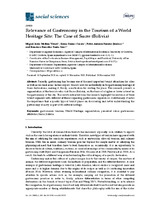Mostrar el registro sencillo del ítem
Relevance of Gastronomy in the Tourism of a World Heritage Site: The Case of Sucre (Bolivia)
| dc.contributor.author | Medina Viruel, Miguel Jesús | |
| dc.contributor.author | Gómez-Casero Fuentes, Gema | |
| dc.contributor.author | Fuentes Jiménez, Pedro Antonio | |
| dc.contributor.author | González Santa Cruz, Francisco | |
| dc.date.accessioned | 2019-11-20T12:30:52Z | |
| dc.date.available | 2019-11-20T12:30:52Z | |
| dc.date.issued | 2019 | |
| dc.identifier.uri | http://hdl.handle.net/10396/19138 | |
| dc.description.abstract | Recently, gastronomy has become one of the most important tourist attractions for cities as well as for rural areas. In this respect, tourists look for authenticity in the gastronomy heritage of these destinations, making it, thusly, a motivation for visiting the place. This research presents a segmentation of the tourists who visit Sucre (Bolivia), on the basis of a higher or lower interest in the gastronomy of the city. The results extracted from the research highlight the existence of three tourist segments with different attitudes regarding gastronomic experiences. Additionally, it notes the importance that a specific type of tourist places on discovering and better understanding the gastronomy of a city as part of its cultural heritage. | es_ES |
| dc.format.mimetype | application/pdf | es_ES |
| dc.language.iso | eng | es_ES |
| dc.publisher | MDPI | es_ES |
| dc.rights | https://creativecommons.org/licenses/by/4.0/ | es_ES |
| dc.source | Social Sciences 8(12), 319 (2019) | es_ES |
| dc.subject | Gastronomic tourism | es_ES |
| dc.subject | World Heritage | es_ES |
| dc.subject | Segmentation | es_ES |
| dc.subject | Perceived value | es_ES |
| dc.subject | Gastronomic attributes | es_ES |
| dc.subject | Sucre (Bolivia) | es_ES |
| dc.title | Relevance of Gastronomy in the Tourism of a World Heritage Site: The Case of Sucre (Bolivia) | es_ES |
| dc.type | info:eu-repo/semantics/article | es_ES |
| dc.relation.publisherversion | http://dx.doi.org/10.3390/socsci8120319 | es_ES |
| dc.rights.accessRights | info:eu-repo/semantics/openAccess | es_ES |

